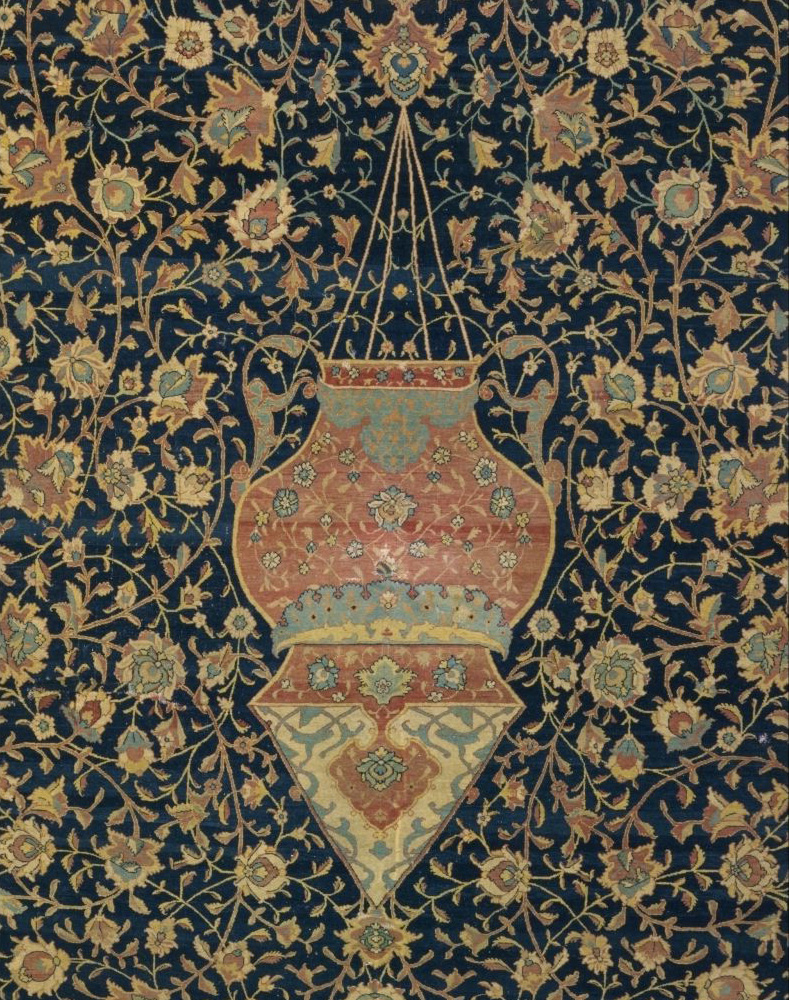The Islamic Sales this week were, as usual, a great chance to see – and even handle – high quality objects. I went to Christies with a friend of mine and we drooled over the only known Mongol carpet (yes, you read that correctly – the only one!). This was not only gorgeous – the demure duck, the cheeky pheasants – but also technically very impressive. It’s a flatweave, woven to be identical front and back. The usual kilim technique means the different colours of horizontal weft create the blocks of colour. But this piece also had the wefts “bent away from the straight horizontal to create curved lines which establish a much clearer graphic”. As well as this, there is a different technique in the section with narrow barber pole stripes. Additionally, the junctions are secured where the different colours meet. This “would have added a considerable amount of time to the weaving process …Where there is a colour change[,] each weft, rather than returning around the warp, is taken to the reverse and there looped around the weft from the adjoining colour, ensuring that there is as strong a join across breaks as there is in the solid blocks of colour.” This prevents the weaving from opening up where the colours change, so making it much stronger and more stable. Even if you don’t care about weft looping, take a look at the design – and marvel! This sold for: $900,135 / £602,500 (in the middle of the estimated price range

Another piece I wanted to highlight was a Shia pilgrimage scroll, including a depiction of the Shrine of Imam ‘Ali al-Riza at Mashhad with multiple hanging lamps in gold and silver. Click here to see the zoomable image.

I thought this was very interesting, only realising how expensive my tastes are when I found that it sold for $48,815 / £32,500 – over twice the top end of the estimate!
The owner of the scroll was a hat-maker from Mashhad who went on pilgrimages to Mecca, Najaf, and Baghdad before settling in Isfahan with his brother. He worked in the Qaysariyya bazaar there, becoming hat-maker to Shah Sulayman himself, before he decided to move back to Mashhad, and take up a life of poverty and asceticism. The last date on the scroll is Muharram AH 1099 [November-December 1687 AD].
The lamps shown on the scroll are almost exactly the same shape as the 1023/1614 silver mosque lamp from Ardabil shown in the British Museum exhibition about Shah Abbas – it’s number 88 in the catalogue. And I also thought I’d remind you of other another – differently shaped – Ardabil hanging light: on the 946/1539-40 Ardabil carpet.
My friend is a doctor, and she was excited to see a Timurid anatomy textbook. Click here and zoom to see some of the great pictures in the book. This sold for: $37,550 / £25,000 (plumb in the middle of the estimate)
YC replied to my reminder that she was quoted in the catalogue that she was maybe actually misquoted “part of my article was to stress the importance of Chinese textiles BEFORE the appearance of the bulk of Yuan porcelain”.
Now now, how about we pool our resources? Divide up that carpet fee by 1000 people, and we each get to roll around on it for 2 days before passing it along to the next….. Convinced? 🙂
JC’s idea is just great! Though I have to say I’m more likely to gawp and drool in my two days. Thanks Jaimee